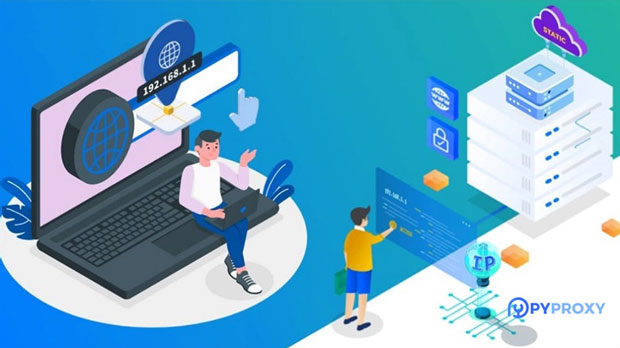Can I protect my privacy by using a proxy IP address? Security Explained
In today's digital age, protecting privacy has become a significant concern for individuals and organizations. With the increasing surveillance on the internet, many people are turning to proxy ip addresses as a solution to hide their online identity. But does using a proxy ip address truly protect privacy? How secure is it? This article will delve into the use of proxy IP addresses for privacy protection, examining their effectiveness, security implications, and potential risks. 1. Understanding Proxy IP AddressesA proxy IP address acts as an intermediary between a user and the internet. When a user connects to the internet via a proxy, their connection is routed through the proxy server, which then connects to the target website or online service. This process hides the user's actual IP address, making it appear as though the connection is coming from the proxy server instead of the user's device.While proxy ips can obscure the user's original IP address, their primary function is to mask the identity of the user. However, it is essential to understand the limitations of proxies and how they function in terms of privacy and security.2. Benefits of Using Proxy IP Addresses for Privacy2.1 Hiding Your Real IP AddressOne of the main reasons individuals use proxy IP addresses is to mask their real IP address. An IP address can reveal a lot of personal information, including the user’s location, browsing habits, and online activities. By using a proxy, users can browse the internet without exposing their actual IP address, making it more difficult for third parties to track their activities.2.2 Enhanced AnonymityUsing a proxy can also enhance online anonymity. Since the proxy server is responsible for making requests to websites, the target websites cannot directly identify the user. This is especially useful for individuals who are concerned about their privacy while browsing, making online purchases, or engaging in any activity that might reveal personal details.2.3 Protection from Tracking and Targeted AdsOnline tracking has become a pervasive issue, with advertisers and websites constantly monitoring users’ behavior to serve targeted ads. Proxy IPs can help reduce the amount of tracking, as the websites only see the proxy's IP address instead of the user's. This can lead to fewer targeted ads and a more private browsing experience.3. Limitations of Proxy IP Addresses3.1 Lack of EncryptionWhile proxies hide the user’s IP address, they do not inherently offer encryption. This means that any data transferred through the proxy server can potentially be intercepted by malicious parties. Unlike a VPN, which encrypts data and secures connections, proxies only change the user's IP address without offering much protection against data breaches.3.2 Risk of Malicious Proxy ServersNot all proxy servers are trustworthy. Some may be set up with the intent to steal users’ data or infect their devices with malware. Public or free proxy servers, in particular, are more likely to be compromised, as they do not prioritize user privacy and security. A malicious proxy server could log users' browsing history, credentials, or personal data, compromising privacy instead of protecting it.3.3 No Protection for Other DataProxy IP addresses only affect the IP address and the information passed through the internet connection. Other types of sensitive data, such as login credentials, credit card numbers, and other personal information, remain vulnerable without additional security measures like encryption or secure connections (HTTPS).4. Comparison Between Proxy IP and Other Privacy Tools4.1 Proxy vs. VPNWhile proxies can hide a user’s IP address, a VPN (Virtual Private Network) goes a step further by encrypting the entire internet connection. A VPN ensures that all data sent over the internet is encrypted, offering a more secure environment than a proxy alone. A proxy IP may only provide anonymity without strong security, whereas a VPN offers both privacy and encryption, making it a more secure option for users who prioritize privacy.4.2 Proxy vs. TorTor, a popular privacy tool, uses a distributed network of servers to anonymize users and encrypt their data. Unlike proxies, which only mask the user’s IP address, Tor provides additional layers of encryption and anonymity, making it harder to track users. However, Tor is generally slower than proxies or VPNs due to the multiple layers of encryption. In terms of privacy protection, Tor offers a higher level of security than proxies, though it may not always be practical for everyday browsing due to its slower speeds.5. Risks Associated with Proxy Use5.1 Data LeakageIn certain cases, data may be accidentally leaked through the proxy server. If the proxy server does not properly handle certain types of traffic, or if there is a flaw in the proxy configuration, sensitive information such as your real IP address or browsing data may be exposed. This could undermine the entire purpose of using a proxy for privacy.5.2 Dependency on the Proxy ProviderWhen using a proxy service, users are essentially trusting the proxy provider to handle their data securely. If the provider keeps logs or engages in questionable practices, it could jeopardize the user’s privacy. Therefore, it is crucial to be cautious about which proxy service you choose, as its policies and actions directly affect your online privacy.5.3 Legal and Ethical ConcernsUsing proxy IP addresses may be legal in many countries, but it can sometimes raise ethical or legal concerns, especially if they are used to circumvent restrictions or engage in activities that are against the law. Users should be aware of the potential legal implications of proxy use, especially when accessing restricted content or engaging in activities that may violate local laws or terms of service.6. How to Enhance Security When Using a Proxy6.1 Choose a Secure Proxy ProviderTo ensure privacy protection, it is essential to choose a trustworthy and secure proxy provider. Look for a provider that does not log user activity, uses secure protocols, and has a reputation for maintaining user privacy. Ideally, choose paid proxies over free ones, as paid services often offer better security and reliability.6.2 Use HTTPS ConnectionsEven though a proxy hides your IP address, it does not encrypt your data by default. To enhance security, always ensure that the websites you visit use HTTPS, which encrypts the data sent between your browser and the website. This adds an additional layer of security to your internet browsing experience, even when using a proxy.6.3 Combine Proxy with Other Privacy ToolsFor greater security, consider combining proxy usage with other privacy tools, such as VPNs or Tor. While proxies offer some level of anonymity, combining them with encryption tools can help to ensure that your data is both private and secure.7. ConclusionIn conclusion, while proxy IP addresses can help protect privacy by masking a user's real IP address, they are not foolproof. Proxies provide a certain level of anonymity but do not offer robust encryption or protection against data breaches. To achieve a higher level of security, users should consider using additional tools like VPNs, ensure secure browsing with HTTPS, and be cautious when selecting a proxy provider. By understanding the limitations and risks of proxies, users can make informed decisions about their online privacy and security.
2025-01-23
























































